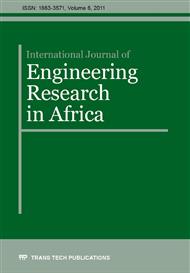[1]
Y. Zhang, Z. Fang, R. Li, W. Hu, The Design and Implementation of a RSSI-Based Localization System. IEEE 5th Int. Conf. on Wireless Communications, Networking and Mobile Computing, (2009) 1-4.
DOI: 10.1109/wicom.2009.5303968
Google Scholar
[2]
K. Romer, and F. Mattern, The Design Space of Wireless Sensor Networks, IEEE Journal: Wireless Communications, 11 (6) (2004) 54-61.
DOI: 10.1109/mwc.2004.1368897
Google Scholar
[3]
R. Heddergott, and P.E. Leuthold, An Extension of Stochastic Radio Channel Modeling Considering Propagation Environments with Clustered Multipath Components, IEEE Transactions on Antenna and Propagation. 51 (8) (2003).
DOI: 10.1109/tsp.2003.815448
Google Scholar
[4]
D. Puccinelli and M. Haenggi, Multipath Fading in Wireless Sensor Networks: Measurements and Interpretation, in Proc. IEEE/ACM Int. Wireless Communication Mobile Comput. Conf. (IWCMC'06), Vancouver, Canada (2006) 1039-1044.
DOI: 10.1145/1143549.1143757
Google Scholar
[5]
M. Lindhe, K.H. Johansson, and A. Bichi, (2007).
Google Scholar
[6]
C. Pu, and Y. Chung, Mitigation of Multipath Fading Effects to Improve Indoor RSSI Performance, IEEE Sensors Journal: 8 (11) (2008) 1884-1886.
DOI: 10.1109/jsen.2008.2006453
Google Scholar
[7]
J.L. Chu, and Kiang, Multipath effects on beacon performances, IEEE International Conference on Networking, Sensing and Control, 1 (2004) 635-638.
DOI: 10.1109/icnsc.2004.1297513
Google Scholar
[8]
R. Wu, Y. Lee, H. Tseng Y. Jan, and M. Chuang, Study of Characteristics of RSSI Signal, IEEE International Conference on Industrial Technology (IEEE ICIT), (2008) 1-3.
DOI: 10.1109/icit.2008.4608603
Google Scholar
[9]
S. Hara, D. Zhao, K. Yanagihara, J. Taketsugu, K. Fukui, S. Fukunaga, and K. Kitayama, Propagation Characteristics of IEEE 802. 15. 4 Radio Signal and Their Application for Location Estimation, IEEE Veh. Technology Conf., 1 (2005) 97-101.
DOI: 10.1109/vetecs.2005.1543257
Google Scholar
[10]
Q. Lymberopoulos, Q. Lindsley, and A. Savvides, An Empirical Characterization of Radio Signal Strength Variability in 3-D IEEE 802. 15. 4 Networks Using Monopole antennas, Lecture Notes in Computer Science, 3868 (2006) 326-341.
DOI: 10.1007/11669463_24
Google Scholar
[11]
M.M. Holland, R.G. Aures, and W.B. Heinzelman, Experimental Investigation of Radio Performance in Wireless Sensor Networks, IEEE WiMesh, (2006) 140-150.
DOI: 10.1109/wimesh.2006.288630
Google Scholar
[12]
T. Chrysikos, G. Georgopoulos, and S. Kotsopoulos, Site-Specific Validation of ITU Indoor Path Loss Model at 2. 4 GHz, IEEE Journal on Wireless Mobile and Multimedia Networks and Workshops, International Symposium, 7 (2009) 1-6.
DOI: 10.1109/wowmom.2009.5282432
Google Scholar
[13]
P. Bellavista, A. Corradi, and C. Giannelli, Evaluating filtering strategies for decentralized handover prediction in the wireless internet, In Proc. ISCC, Sardinia, Italy (2006) 167-174.
DOI: 10.1109/iscc.2006.70
Google Scholar
[14]
R. Pahtma, R. Preden, R. Agar, and P. Pikk, Utilization of Received Signal Strength Indication by Embedded Nodes, Journal: Electronics and Electronic Engineering . - Kaunas: Technologija, 93 (50) (2009) 39-42.
Google Scholar
[15]
K. Pahlavan, and M. Kanaan, A comparison of Wireless geolocation algorithms in indoor environments, Wireless Communication and Networking Conference, WCNC IEEE, 1 (2004) 21-25.
DOI: 10.1109/wcnc.2004.1311539
Google Scholar
[16]
A. Pekou, V. Nastos, N. Moraitis, and P. Constantitiou, Time Delay and Coherence Bandwidth Measurements at 60GHz in an indoor environment for WLANS, IEEE Vehicular Technology Conference, 1 (2004) 93-97.
DOI: 10.1109/vetecs.2004.1387919
Google Scholar
[17]
D. Pena, R. Feick, H. Hristov, and W. Grote, Measurements and modeling of propagation losses in brick and concrete walls at the 900-Mhz Band, IEEE Trans., Antenna Propagation, 51 (2003) 31-39.
DOI: 10.1109/tap.2003.808539
Google Scholar
[18]
R. Feick, H.D. Hristov, W. Grote, and D. Pena, Attenuation Measurements for Double-Mesh Reinforced concrete walls at the 900-Mhz Cellular Band, Department of electronic Engineering, Universidad Technica Federico Santa Maria, Valparaiso, Casilla 110V, Chille. IEEE Trans. on Antennas Propagation. (2003).
DOI: 10.1109/tap.2003.808539
Google Scholar
[19]
M. Dehmollaian, Hybrid Electromagnetic Models for the Purpose of Detection and Identification of Visually Obscured Targets, PhD Dissertation in Electrical Engineering at The University of Michigan (2007).
Google Scholar
[20]
L. Sandrolini, U. Reggiani, and A. Ogunsola, Modeling the electrical properties of concrete for shielding effectiveness prediction. Journal of Physics: Applied Physics, 40 (2007) 5360-5372.
DOI: 10.1088/0022-3727/40/17/053
Google Scholar
[21]
J. Edler, M. Oskowsky, and W. Wang, Wireless mesh network for building automation Technical article: Industrial Wireless book issue 10: 2 (2005).
Google Scholar


